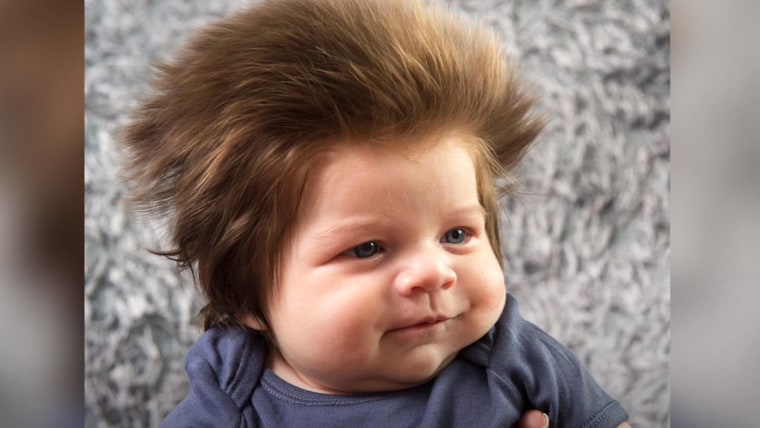
Baby With Hair: A Comprehensive Guide to Understanding and Caring for Your Little One’s Locks
The arrival of a newborn baby is a momentous occasion, filled with joy, love, and anticipation. Along with the adorable features and tiny limbs, some babies may surprise their parents with a full head of hair, while others may be born with just a few wisps. Whether your baby is born with a thick mane or a delicate fuzz, understanding and caring for their hair is an important part of their overall well-being.
Why Do Some Babies Have Hair at Birth?
The presence of hair on a newborn baby is influenced by several factors, including genetics, ethnicity, and hormonal levels.
-
Genetics: The genes inherited from both parents play a significant role in determining the amount and texture of a baby’s hair. Some families have a history of babies with thick, dark hair, while others may have babies with fine, light-colored hair.
-
Ethnicity: Certain ethnic groups are more likely to have babies with hair at birth. For example, Asian and Native American babies often have thicker, darker hair than Caucasian babies.
-
Hormonal Levels: Hormones produced by the mother during pregnancy can also affect the growth of a baby’s hair. Higher levels of certain hormones, such as estrogen, can stimulate hair growth in the fetus.
Types of Newborn Hair
Newborn hair can vary in texture, color, and thickness. Here are some common types:
-
Lanugo: This is the fine, downy hair that covers a baby’s body in the womb. It usually sheds within a few weeks after birth.
-
Vellus Hair: This is the soft, thin hair that replaces lanugo. It is typically lighter in color and less noticeable.
-
Terminal Hair: This is the thicker, coarser hair that grows on the scalp and other parts of the body. It is the type of hair that will continue to grow throughout a person’s life.
Caring for Your Baby’s Hair
While newborn hair is delicate, it still requires proper care to maintain its health and appearance. Here are some tips:
-
Wash Gently: Use a mild, tear-free shampoo and warm water to wash your baby’s hair. Avoid using harsh soaps or detergents, as they can irritate the scalp.
-
Brush Regularly: Use a soft-bristled brush to gently brush your baby’s hair. This will help to remove any tangles and distribute natural oils.
-
Avoid Over-Styling: Avoid using hair products or styling tools on your baby’s hair. These can damage the delicate hair shafts.
-
Protect from the Sun: If your baby is exposed to the sun, cover their head with a hat or bonnet to protect their hair from damage.
-
Monitor for Cradle Cap: Cradle cap is a common condition in newborns that causes dry, flaky patches on the scalp. If you notice any signs of cradle cap, consult with your pediatrician for treatment options.
When to Expect Hair Growth
The rate of hair growth in babies varies greatly. Some babies may experience rapid hair growth within the first few months, while others may have slower growth. Here is a general timeline of what to expect:
-
Birth to 3 Months: Most babies will lose their lanugo hair and develop vellus hair during this time.
-
3 to 6 Months: Terminal hair may start to grow on the scalp.
-
6 to 12 Months: The baby’s hair may become thicker and longer.
-
12 to 18 Months: The baby’s hair may reach its full length and texture.
Hair Loss in Babies
It is common for babies to experience some hair loss during the first few months of life. This is usually due to hormonal changes and friction from rubbing against the crib or car seat. Hair loss typically stops within a few months, and the baby’s hair will start to grow back.
Medical Conditions and Hair Loss
In rare cases, hair loss in babies can be a sign of an underlying medical condition, such as:
-
Alopecia areata: This is an autoimmune condition that causes patchy hair loss.
-
Ringworm: This is a fungal infection that can cause hair loss in circular patches.
-
Thyroid problems: Thyroid disorders can affect hair growth and lead to hair loss.
If you notice any unusual hair loss or other symptoms in your baby, consult with your pediatrician for evaluation.
Conclusion
Whether your baby is born with a full head of hair or just a few wisps, understanding and caring for their locks is an important part of their overall well-being. By following these tips, you can help to keep your baby’s hair healthy, beautiful, and a source of joy for years to come. Remember, every baby is unique, and the growth and development of their hair will vary. If you have any concerns or questions, do not hesitate to consult with your pediatrician for guidance.
